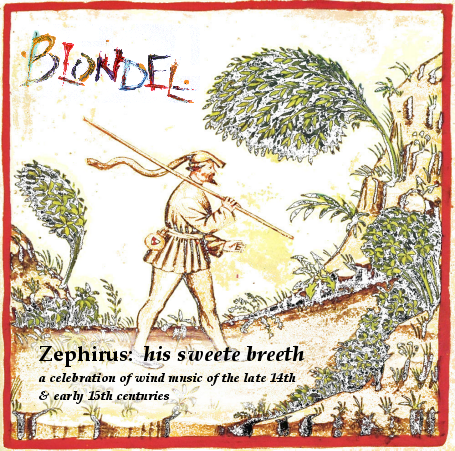Zephirus: his sweete breeth
A celebration of wind music of the late 14th and early 15th centuries
Emily Baines, Belinda Paul and Lizzie Gutteridge – shawms, bagpipes and recorders.

Blondel’s inaugural recording is an auspicious start to what one hopes will be a long performing and recording life for the group. Sensibly, they do not attempt too much: there are only three performers, and the CD is on the short side at under 52 minutes. But the performances are excellent, and while the group does not make the mistake of over-“orchestrating” the music, there is enough variation in the performances to prevent any feeling of sameness as the CD progresses.
The repertory is from the late 14th and early 15th centuries, including music by Machaut and Dufay, with single tracks from some of their contemporaries. Of the dance-tunes surviving from this period Blondel do play the Danse de Cleves and La Franchoise Nouvelle from the manuscript of Margaret of Austria, but the bulk of the recording presents vocal music played instrumentally. Given that minstrels could certainly learn and play composed music, decorating it and extemporising around it, and that some of the best minstrels could read at least relatively simple notation, this is a credible repertory for performance on wind instruments.
Performing vocal music on instruments raises several important questions about how one treats the music. A monophonic song by Machaut receives a counter-tune (it is played on two bagpipes), which seems entirely the right sort of creativity for performance by minstrels. On the other hand, the players are modest throughout in their decoration of melodic lines. Wind players would certainly have decorated such music, taking a tune that they had memorised and working on it in various ways. Blondel tend not to decorate, or to do so sparingly, and certainly that is preferable to over-decoration or inept decoration. There is no evidence that Blondel would ever be guilty of these, of course, but committing to particular decorations and styles of decoration on your first CD may well be best avoided. This is something for the future, perhaps.
The question of the treatment of texts also arises, even when nothing is sung. Clearly, Blondel’s approach to each piece does take account of the texts, each song being played on appropriate instruments – shawms for the most energetic and ceremonial pieces, bagpipes for more thoughtful music, and recorders for the most reflective songs. This categorisation is certainly coarse-grained, but the three groups of instruments are important in defining the shape of the repertory performed: three songs on shawms, three on recorders, a longer piece on bagpipes, another two on shawms, and so on.
Part of the question of text-treatment is that of the formes fixes. Blondel take a sensible approach that recognises the particular repetition-patterns demanded by each. Songs retain their basic structural characteristics, but these are sometimes modified. For example, in a virelai (of structure ABBAA, where A and B are the two musical sections) where two stanzas are needed to prevent the piece being too short, not every section of the two stanzas needs to be performed if no text is involved: so the three adjacent A sections in the structure ABBAA ABBAA are reduced to two. Similarly, in a rondeau (ABAAABAB) the adjacent A sections can again be reduced to two without losing any of the various connections (A to A, A to B, B to A) that the form offers. On the other hand, in a ballade there is no problem in playing two complete stanzas (ABB ABB).
The standard of performance is high on this CD. As I noticed in a live performance some months ago, the shawm ensemble is firmly in tune, and all the stronger for that; the recorder-playing is sensitive; and the bagpipes are exciting in the relatively uninvasive way that bagpipes are (relative to the shawms, that is, which grab you by the ears and shake you around). The energy given to these performances is obvious, as is the high standard of musicianship.
The CD’s tracks are listed on the back of the case and in the liner notes. The notes give information about the instrumentation, but (rather frustratingly) not for every track. In general, more information in the notes would help listeners who do not know this sort of repertory. It would be helpful to say what each song is about, even if text and translation are not given (a matter that one could discuss!). This is not because it might influence the way that one listens to the music (though that could be argued), but rather because the songs are otherwise meaningless as such – just titles – rather than items in a highly-developed musical and poetic culture that is worth exploring in all possible ways.
Belinda Paul’s notes do provide some discussion of the texts, and are useful in explaining a medieval sensibility that we might find difficult. While the formes fixes are mentioned in connection with Machaut’s virelais, there would be a case for explaining how virelais, ballades and rondeaux worked, since the structures chosen here relate to them. At the least one would like to know why the group chose this particular repertory and how they think it relates to what minstrels actually performed at the time. These musicological questions may seem irrelevant to some, but others will think it important to set out possibilities – to tell the listener that this is only a tiny fraction of the repertory, and to say what we know about this music (or don’t know, for that matter) and how it can be performed.
These notes are well thought out: the historical introduction to the 14th and early 15th centuries will be helpful to a modern listener, while the brief information on the instruments and on the group itself are exactly what one immediately needs on settling down to listen to this CD. For some listeners this will be enough; others will want more.
I hope that this CD will sell well enough to encourage Blondel to issue another, and that the next one will be fuller both in the overall length of the music and in the information given in the notes. This is a splendid first recording, and it would be good to have another CD from Blondel soon: I gather that two more are in fact in preparation. Zephirus: his sweete breeth is available from Blondel via their website: www.renaissance-winds.com
Richard Rastall,
January 2016.
